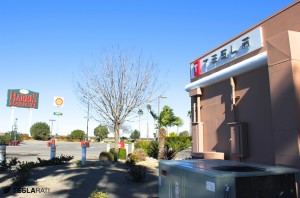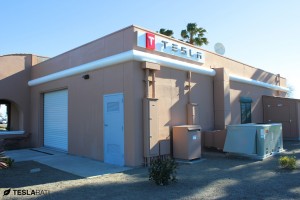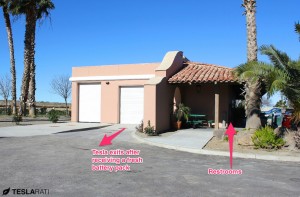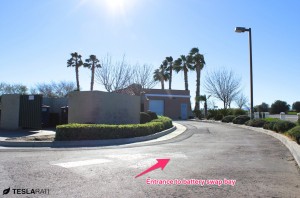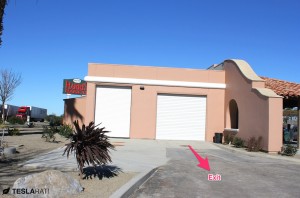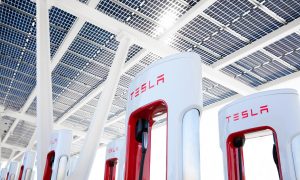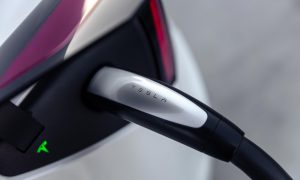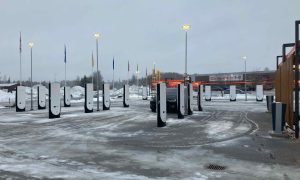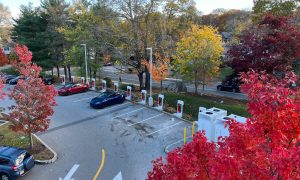News
Tesla shuts down battery swap program in favor of Superchargers, for now
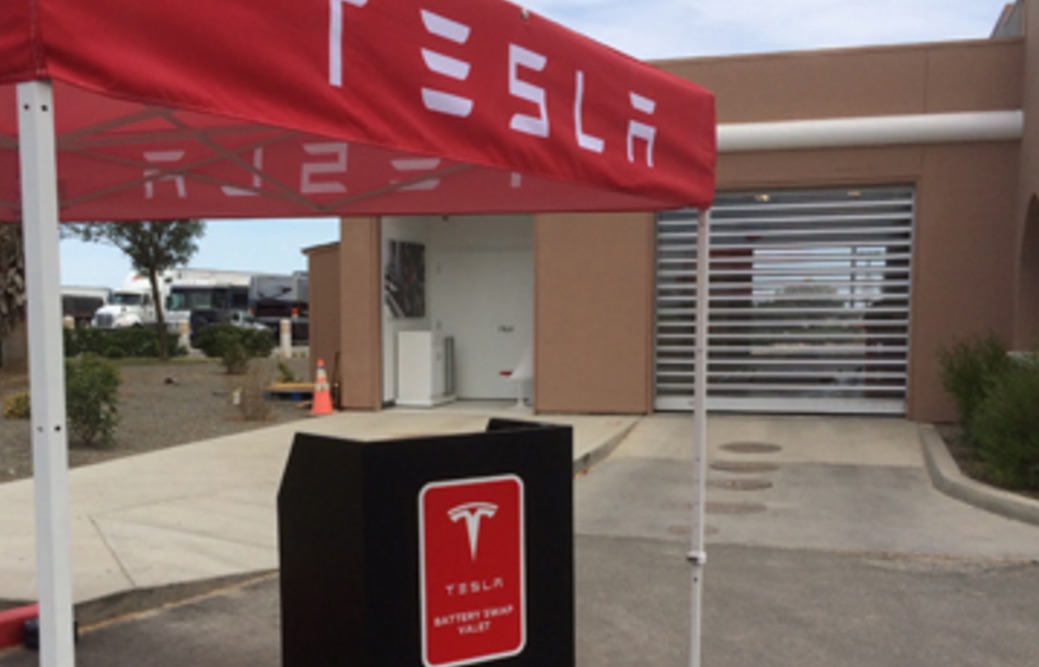
Tesla’s battery swap station near the Harris Ranch Supercharger station in Coalinga, CA seems to have been shut down, at least for now. What started out as a company vision to recharge Tesla vehicles in the same amount of time, if not quicker, as refueling a gas vehicle, turned into a pilot program that saw little to no fanfare.
Now, three years after Tesla first demonstrated the ability to quickly swap out the floor-mounted battery on a Model S and replace it with a fully charged battery pack, the company has seemingly closed the pilot program in favor of expanding its global network of Superchargers.
The news comes from a Tesla owner who had been following the development of the battery swap station off Interstate 5 (I-5) since its first debut. TeslaOwner accounts on their blog the experience with using Tesla’s battery swap program.
![Battery Swap station at Harris Ranch [Credit: TeslaOwner]](http://www.teslarati.com/wp-content/uploads/2014/12/141222enteringswap.jpg)
Battery Swap station at Harris Ranch [Credit: TeslaOwner]
TeslaOwner described the battery swap process as being a mix of machine and human. Any automation that occurred during the exchange was augmented by humans. Swap time was, on average, seven minutes. There was some trepidation that, upon returning the battery, a driver would receive a different battery with more accumulated mileage on it. Onboard technology did not recognize the swap and assumed that the original trip totals were continuing.
“Presently the Battery Swap Program is not accepting any new requests for appointments.”
Since experiencing the battery swap last July, TeslaOwner tells us that the same station has remained relatively quiet and “looked quite closed” each time they’ve driven by the station which appeared to have no activity.
This prompted them to inquire with Tesla about scheduling an appointment for another battery swap. According to TeslaOwner, they received a response from the Service Manager for the battery swap station, indicating that Tesla is no longer taking requests for appointments. “Presently the Battery Swap Program is not accepting any new requests for appointments.”
The viability of battery swaps moving forward
The Tesla proprietary charging station service was projected to be able to support both battery pack swaps as well as fast recharging of the Tesla Model S and Model X electric vehicle battery packs. By December 2014, 18 months after the original announcement, no battery swapping stations had yet opened to the public. Then a single battery-swap station was opened in California as a pilot project, where only invited Model S owners could do battery swaps by appointment, to assess technical and economic aspects of the service. Demand for the priced service would be used to determine whether the company would fully commercialize battery swapping stations more generally.
Photos captured of the Tesla battery swap station at Harris Ranch from December, 2014
By June 2015, the company had indicated that the battery swapping capability was no longer a significant part of Tesla’s plans for on-road energy replacement for their vehicles. Tesla’s standardization of car and the swapping stations alongside battery and battery fasteners prohibited other EV car owners from utilizing the battery swap station. For battery swapping to grow, the following conditions might need to be considered:
- Find strategic locations for battery swapping;
- Use alternative energy onsite to recharge batteries;
- Draw upon grid electricity when it is off-peak, cheapest, or when the more environmental energy generation is available;
- Assure customers that swapped batteries have comparable life expectancy in relation to the original;
- Incorporate fleet vehicles to reduce battery swapping costs overall.
The Tesla battery swap program doesn’t receive much press these days, given the news about the impending SolarCity merger and glass roof tiles, among the other constant Tesla technological innovations. Work on accelerating the rollout of Supercharger stations ahead of the Model 3 coming to market next year seems most critical. Moreover, regular Tesla owners at this moment in time don’t really seem to find the battery swap option as attractive as the Supercharger.
Of course, speculation continues to swirl. Tesla recently hired Audi’s North America commercial account manager to lead a new B2B push for Tesla in “fleet management, rental, government/public sectors & corporate enterprises.” Large commercial fleets of Tesla vehicles could change many aspects of the way that Tesla provides services, including a revisit to the battery swap with special, private fleet stations.
News
Tesla UK sales see 14% year-over-year rebound in June: SMMT data
The SMMT stated that Tesla sales grew 14% year-over-year to 7,719 units in June 2025.

Tesla’s sales in the United Kingdom rose in June, climbing 14% year-over-year to 7,719 units, as per data from the Society of Motor Manufacturers and Traders (SMMT). The spike in the company’s sales coincided with the first deliveries of the updated Model Y last month.
Model Y deliveries support Tesla’s UK recovery
Tesla’s June performance marked one of its strongest months in the UK so far this year, with new Model Y deliveries contributing significantly to the company’s momentum.
While the SMMT listed Tesla with 7,719 deliveries in June, independent data from New AutoMotive suggested that the electric vehicle maker registered 7,891 units during the month instead. However, year-to-date figures for Tesla remain 2% down compared to 2024, as per a report from Reuters.
While Tesla made a strong showing in June, rivals are also growing. Chinese automaker BYD saw UK sales rise nearly fourfold to 2,498 units, while Ford posted the highest EV growth among major automakers, with a more than fourfold increase in the first half of 2025.
Overall, the UK’s battery electric vehicle (BEV) demand surged 39% to to 47,354 units last month, helping push total new car sales in the UK to 191,316 units, up 6.7% from the same period in 2024.
EV adoption accelerates, but concerns linger
June marked the best month for UK car sales since 2019, though the SMMT cautioned that growth in the electric vehicle sector remains heavily dependent on discounting and support programs. Still, one in four new vehicle buyers in June chose a battery electric vehicle.
SMMT Chief Executive Mike Hawes noted that despite strong BEV demand, sales levels are still below regulatory targets. “Further growth in sales, and the sector will rely on increased and improved charging facilities to boost mainstream electric vehicle adoption,” Hawes stated.
Also taking effect this week was a new US-UK trade deal, which lowers tariffs on UK car exports to the United States from 27.5% to 10%. The agreement could benefit UK-based EV producers aiming to expand across the country.
News
Tesla Model 3 ranks as the safest new car in Europe for 2025, per Euro NCAP tests
Despite being on the market longer than many of its rivals, the Tesla Model 3 continues to set the bar for vehicle safety.

The Tesla Model 3 has been named the safest new car on sale in 2025, according to the latest results from the Euro NCAP. Among 20 newly tested vehicles, the Model 3 emerged at the top of the list, scoring an impressive 359 out of 400 possible points across all major safety categories.
Tesla Model 3’s safety systems
Despite being on the market longer than many of its rivals, the Tesla Model 3 continues to set the bar for vehicle safety. Under Euro NCAP’s stricter 2025 testing protocols, the electric sedan earned 90% for adult occupant protection, 93% for child occupant protection, 89% for pedestrian protection, and 87% for its Safety Assist systems.
The updated Model 3 received particular praise for its advanced driver assistance features, including Tesla’s autonomous emergency braking (AEB) system, which performed well across various test scenarios. Its Intelligent Speed Assistance and child presence detection system were cited as noteworthy features as well, as per a WhatCar report.
Other notable safety features include the Model 3’s pedestrian-friendly pop-up hood and robust crash protection for both front and side collisions. Euro NCAP also highlighted the Model 3’s ability to detect vulnerable road users during complex maneuvers, such as turning across oncoming traffic.
Euro NCAP’s Autopilot caution
While the Model 3’s safety scores were impressive across the board, Euro NCAP did raise concerns about driver expectations of Tesla’s Autopilot system. The organization warned that some owners may overestimate the system’s capabilities, potentially leading to misuse or inattention behind the wheel. Even so, the Model 3 remained the highest-scoring vehicle tested under Euro NCAP’s updated criteria this year.
The Euro NCAP’s concerns are also quite interesting because Tesla’s Full Self-Driving (FSD) Supervised, which is arguably the company’s most robust safety suite, is not allowed for public rollout in Europe yet. FSD Supervised would allow the Model 3 to navigate inner city streets with only minimal human supervision.
Other top scorers included the Volkswagen ID.7, Polestar 3, and Geely EX5, but none matched the Model 3’s total score or consistency across categories. A total of 14 out of 20 newly tested cars earned five stars, while several models, including the Kia EV3, MG ZS, and Renault 5, fell short of the top rating.
Elon Musk
Why Tesla’s Q3 could be one of its biggest quarters in history
Tesla could stand to benefit from the removal of the $7,500 EV tax credit at the end of Q3.

Tesla has gotten off to a slow start in 2025, as the first half of the year has not been one to remember from a delivery perspective.
However, Q3 could end up being one of the best the company has had in history, with the United States potentially being a major contributor to what might reverse a slow start to the year.
Earlier today, the United States’ House of Representatives officially passed President Trump’s “Big Beautiful Bill,” after it made its way through the Senate earlier this week. The bill will head to President Trump, as he looks to sign it before his July 4 deadline.
The Bill will effectively bring closure to the $7,500 EV tax credit, which will end on September 30, 2025. This means, over the next three months in the United States, those who are looking to buy an EV will have their last chance to take advantage of the credit. EVs will then be, for most people, $7,500 more expensive, in essence.
The tax credit is available to any single filer who makes under $150,000 per year, $225,000 a year to a head of household, and $300,000 to couples filing jointly.
Ending the tax credit was expected with the Trump administration, as his policies have leaned significantly toward reliance on fossil fuels, ending what he calls an “EV mandate.” He has used this phrase several times in disagreements with Tesla CEO Elon Musk.
Nevertheless, those who have been on the fence about buying a Tesla, or any EV, for that matter, will have some decisions to make in the next three months. While all companies will stand to benefit from this time crunch, Tesla could be the true winner because of its sheer volume.
If things are done correctly, meaning if Tesla can also offer incentives like 0% APR, special pricing on leasing or financing, or other advantages (like free Red, White, and Blue for a short period of time in celebration of Independence Day), it could see some real volume in sales this quarter.
You can now buy a Tesla in Red, White, and Blue for free until July 14 https://t.co/iAwhaRFOH0
— TESLARATI (@Teslarati) July 3, 2025
Tesla is just a shade under 721,000 deliveries for the year, so it’s on pace for roughly 1.4 million for 2025. This would be a decrease from the 1.8 million cars it delivered in each of the last two years. Traditionally, the second half of the year has produced Tesla’s strongest quarters. Its top three quarters in terms of deliveries are Q4 2024 with 495,570 vehicles, Q4 2023 with 484,507 vehicles, and Q3 2024 with 462,890 vehicles.
-

 Elon Musk4 days ago
Elon Musk4 days agoTesla investors will be shocked by Jim Cramer’s latest assessment
-

 News1 week ago
News1 week agoTesla Robotaxi’s biggest challenge seems to be this one thing
-

 Elon Musk2 weeks ago
Elon Musk2 weeks agoFirst Look at Tesla’s Robotaxi App: features, design, and more
-

 News2 weeks ago
News2 weeks agoSpaceX and Elon Musk share insights on Starship Ship 36’s RUD
-

 News2 weeks ago
News2 weeks agoWatch Tesla’s first driverless public Robotaxi rides in Texas
-

 News1 week ago
News1 week agoWatch the first true Tesla Robotaxi intervention by safety monitor
-

 News2 weeks ago
News2 weeks agoTesla has started rolling out initial round of Robotaxi invites
-

 Elon Musk2 weeks ago
Elon Musk2 weeks agoTesla to launch in India in July with vehicles already arriving: report

